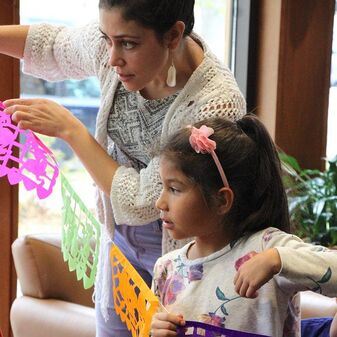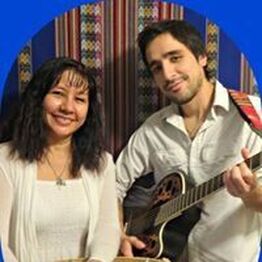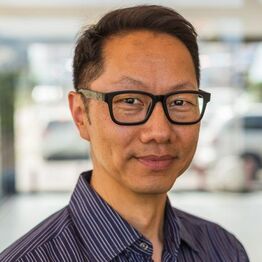This Little Light of Mine; Is Mine! Reflecting on A Concert with Artist in Residence, Lester Mayers12/3/2022 Lia Rivamonte, Artist in Residence and Beloved Community Communications Teams  “The idea is to write it so that people hear it, and it slides through the brain and goes straight to the heart.” — Maya Angelou Every once in a while, we are lucky to witness a thing of beauty. In nature, a spectacular sunset, a fall maple ablaze in color, for example, will provoke shudders. In art, a passage of music, a stunning painting may delight and move us, making us grateful to be human. Those of us able to witness Lester’s show on Saturday, November 12, 2022, received such a gift: one of hope, and love, and yes, beauty. Lester and his friends delivered an emotional wallop through poetry and song that described lives of difficult, traumatic relationships impacted by addiction, social and racial injustice, and poverty. Abandonment, neglect, and rejection can be survived if we can muster the wherewithal to believe in ourselves and in our own self-worth despite what the world seems to be telling us. And when that moment comes when we can see ourselves as worthy of love—as it must—it’ll be joyful because just as there is more love, “there is more joy somewhere.” Even in those bluest hours so often susceptible to despair, it is there, rooted in the expansive imagination, and in the embrace of community. And while we know it isn’t that simple, that the road to self-acceptance is not straight nor without potholes, it’s the only one that can lead to love. Okay, so, I’m more than a bit biased—I’m a member of the Artist in Residence Team (AiR)—but the decision to select him for AiR was a unanimous one. The purpose of the AiR program to help advance Unity’s vision of becoming an antiracist multicultural community through art was clear; he was willing and very able. As a performer he is a consummate professional—charismatic with a forceful presence, and as a writer his subject is urgent and timely—self-worth and self-love. His method of expression is both artful and raw at the same time. Nothing, however, prepared me for the care and passion he invested in his culminating work as our Artist in Residence. As a lifelong practitioner and advocate of art, I know that art has the power to reach people in real ways. As UU’s we have a tendency to value head over heart, even though we understand the value of engaging our whole selves. A close encounter with art can change us, touch us in unexpected ways, and expand our perception of what it is to be human. “This Little Light of Mine; Is Mine!” is a gift that will keep on giving. Lester and his talented guest artists, Nubia Monks, Siddeeqah Shabazz, and John Jamison put their hearts into their all-too-brief time on the stage. Unity’s musical director Ahmed Anzaldúa provided grace notes on the piano. In the final moments of the performance, Lester, dressed in priestly robes, conjures up the spirit of civil rights activist Fannie Lou Hamer, asking her where and how we can find joy in a world so full of adversity. She reminds him in song, “This Little Light of Mine,” and so we all sing it together. View the concert on Unity’s YouTube channel Learn more about Unity's Artists in Residence Program Check out Lester Mayers’ website
0 Comments
 Artist in Residence Paul Kruse Artist in Residence Paul Kruse Lia Rivamonte, for the Artist in Residence Team and Beloved Community News If you get a call from Paul Kruse, you will want to talk to him. It won’t be hard — he is easy to talk to. Friendly, unassuming, some might even say mild-mannered, he laughs easily —after all he’s from La Crosse for gosh sake. In fact, that may be one of the points he is trying to make with his project, “Once Removed,” a series of audio-based performance pieces, the continuation of a previous work of the same name. The happy-go-lucky, lily-white, hetero-normative, binary, nuclear, so-called Christian family once considered the foundation of rural America was always a myth. A fragile construction built of cheap toothpicks easily blown away when you learn the truth. And how do you learn that truth? You talk to people, give them the space to tell you their stories, and you listen. What are they telling you? What aren’t they telling you? Paul has become very good at listening, and digging deeper into that silence. As Unity’s next Artist in Residence, he has already begun his work, interviewing LGBTQ+ members of the congregation, to learn about their experiences growing up Queer—especially if they were raised away from an urban setting. After earning a degree in filmmaking/video production at Northwestern University, Paul lived for a brief time in Chicago where he ended up working for a Jesuit-run organization, and had to be talked out of becoming a priest by a wise Jesuit mentor. Invited by friends to join them in Pittsburgh, PA, Paul discovered that an active arts community and affordable rents allowed him to flourish as an artist. It was there that he began playwriting in earnest, and where he and friends founded the Hatch Art Collective (2012-2022) producing work throughout the city of Pittsburgh. In 2020, Paul completed his MFA in playwriting at UT Austin and his work has received much attention; his plays are produced throughout the country. Paul’s work typically falls into two distinct categories — fiction and documentary. For example, his play “Chickens in the Yard,” follows a gay couple as they travel from the families who raised them to the family they make together as seen through the eyes of their four chickens. “Once Removed,” is a documentary play, tracing Paul’s own coming-out after piecing together the story of his mother’s gay cousin who died from HIV/AIDS at the age of 31. It was only when he started asking questions and connected the dots by interviewing his mom and later his aunt and other relatives that he learned the truth. Drawn to writing for theatre because of its collaborative nature, Paul finds great joy in conversation and in learning about people. His project at Unity is ambitious and will include interviews with people beyond the congregation. He is captivated and moved by the stories of Queer people, how they grew up, and if they came out, how and when. How did the rest of their family relate to them? He has observed that Queer people don’t often hear stories about themselves. He has set out to change that, and he is especially keen to learn about queerness in Midwestern families. Paul’s mission, as he notes on his website, is to “tell Queer love stories.” Many LGBTQ+ people feel they must leave their families of origin and the small towns that raised them in order to be who they are without judgment, recrimination, and the need to shroud themselves in secrecy. Others have discovered this freedom may actually exist in those places after all. “Love is Love,” as the saying goes. These Queer love stories that Paul wants to tell are not limited to romantic love. The type of love that sustains us can be found or re-discovered in all sorts of places — even in small-town America, and even or especially in the lap of one’s own family. During his residency at Unity, Paul will conduct interviews, lead Wellspring Wednesday sessions, and present a listening gathering and celebration in March to culminate his work with us. Not only do we hope all community members will introduce themselves and make him feel welcome, but we invite everyone to engage in Paul’s work on a deeper level. While his project, “Once Removed,” focuses on the lives of LGBTQ+ people, there will be opportunities for all of us to participate. Paul’s Wellspring Wednesday sessions will provide a glimpse into his creative process, and he will share some effective approaches to having meaningful and sometimes difficult conversations with family members, others we care about, and even strangers. The culminating listening session will be a chance to celebrate our connection to one another. We are not all the same but our differences do not have to separate us. By sharing our stories, we break the silence that isolates. This is work that asks us to further develop our “going deep quickly” practice, one of the personal spiritual practices referred to in Unity’s Double Helix Model of faith formation and antiracist multiculturalism. The intention of Unity’s Artist in Residence program is to “activate our imagination, foster relationships among and beyond our church walls, inspire spiritual and emotional growth, and open the church community to larger dimensions in the work of making cultural change.” We believe that Paul’s residency and that of our other artist residencies, helps to advance Unity’s vision of becoming an antiracist multicultural Beloved Community. Lia Rivamonte, on behalf of the Beloved Community Communications Team and Artist in Residence Team It was October of 2019 when Rebekah Crisanta de Ybarra began her artist residency at Unity Church. Rebekah is an interdisciplinary artist who identifies as Indigenous-Salvadoran-Norwegian-American and is based in the Twin Cities. Among the activities Rebekah offered was a hands-on demonstration of her approach to creating the Aztec-rooted ritual ofrenda for Día de los Muertos, the altar to honor loved ones who have died. This community presentation was the first official event of the Unity Church Artist in Residence (AiR) program. AiR is an effort to embody multiculturalism through art, inviting gifted artists whose art practices explore the world from the vantage point of their own singular intersectional identities that are not predominantly white-bodied or white-directed. Much has transpired since that first presentation. In February of 2020 Ina Yukka, the mother and son duo of Nia Biagetti and Vladimir Garrido brought enchanting Latin American folk music and dance into the building with worship service performances and workshops, but the Covid-19 lockdown prevented their long-planned in-person concert, and the remainder of their residency had to be conducted virtually. Despite needing to move into all-virtual programs and events, the AiR Team invited social practice-interdisciplinary artist Marcus Young to serve as resident artist. Marcus and his collaborators from DYFIT (Don’t You Feel It Too) encouraged us to move our bodies in any given space, uniting music and our intrinsic rhythms — in equal parts meditation and celebration — in the practice of public dance. It seems ironic that a program meant to concretize our understanding of multiculturalism, inviting us to bring our whole selves into unfamiliar realms as individuals and as a community had to be experienced in our own, separate, cozy rooms at home by screen. And while the artists with whom we’ve been fortunate enough to work thus far have all been exemplary, their work widely known and extolled by critics and audiences alike, the unplanned barriers to participation that have beset the program for these last eighteen months have prevented the type of community engagement the AiR Team had hoped for. Add to this our lack of clarity regarding some aspects of the program including logistics and implementation, and we realized some changes were due.
We asked ourselves how we might nurture deeper artist-community relationships and raise the level of engagement by congregants? We thought about how to be more intentional in what we hope to accomplish: integrating arts opportunities for learning and discovery with Unity’s Ends, providing an opportunity for artists to expand their art, and offering the potential for spiritual growth and multicultural understanding for our church community as well as participating artists. Of course, we’d hoped by now, we would all feel safe to meet in person. But while that has not yet happened, we are excited to move into the next phase of AiR. We have created program guidelines that outline the goals, expectations, and timelines for artist projects and we are reaching out to the broader Twin Cities artist community with a request for proposals (RFP). Eligible artists who take the time to familiarize themselves with Unity Church, our mission, values, and ends before applying for the program will have the advantage. The application guidelines and deadline for submission will be posted on Unity's website. The team will then cull through the proposals, conduct interviews with a select group of artists, and hope to identify the next artist in residence by April or May 2022. We hope that what we have re-envisioned will be a program that is more accessible to community members, allows for greater relationship-building, sparks our imaginations, and provides us with creative experiences that engender wonder, curiosity, and a profound recognition of and appreciation for our differences as human beings. The AiR team members are: Lia Rivamonte, Ahmed Anzaldúa, Julia Brown, and Maura Williams. For more information visit www.unityunitarian.org/artist-in-residence.html. |
Topics
All
Beloved Community ResourcesUnity Justice Database
Team Dynamics House of Intersectionality Anti-Racism Resources in the Unity Libraries Collection Creative Writers of Color in Unity Libraries The History of Race Relations and Unity Church, 1850-2005 Archives
July 2024
Beloved Community Staff TeamThe Beloved Community Staff Team (BCST) strengthens and coordinates Unity’s antiracism and multicultural work, and provides opportunities for congregants and the church to grow into greater intercultural competency. We help the congregation ground itself in the understanding of antiracism and multiculturalism as a core part of faith formation. We support Unity’s efforts to expand our collective capacity to imagine and build the Beloved Community. Here, we share the stories of this journey — the struggles, the questions, and the collaborations — both at Unity and in the wider world.
The current members of the Beloved Community Staff Team include Rev. Kathleen Rolenz, Rev. KP Hong, Rev. Lara Cowtan, Drew Danielson, Laura Park, Lia Rivamonte and Angela Wilcox. |


